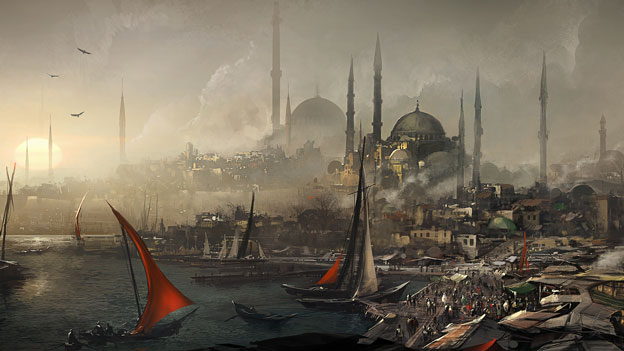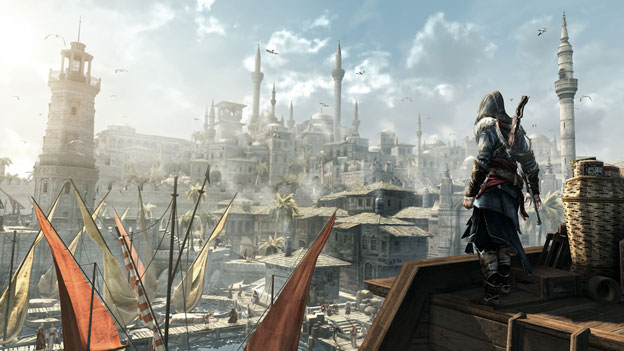An Assassin’s Renaissance?
Let’s remove the Desmond element from the Assassin’s Creed mythology for a moment. In doing so, we’re left with two loosely connected characters: Altaïr Ibn-La’Ahad and Ezio Auditore da Firenze. There are others, especially in the series’ non-interactive fiction, but these are the two characters that players control.
There have been three Assassin’s Creed games released on the high-definition consoles (and PC). Of these, only the first featured Altaïr in a prominent role, the others almost exclusively centered on the inarguably more charming Ezio. It’s only natural, then, that the newest addition to the series, Assassin’s Creed: Revelations, should follow him as well. Yet while both Assassin’s Creed II and Brotherhood were tales of revenge, with Ezio either working his way up from nothing to a competent assassin or building a guild of assassins both in pursuit of the brotherhood’s goals and of his own satisfaction, Revelations is about self-discovery. Ubisoft promises that in Revelations, Ezio’s travels to Constantinople will help unveil the greater connection between him and the first game’s protagonist, Altaïr.

It’s interesting, then, that Ezio’s journey of self-enrichment comes so late in his life. Throughout the series, time has progressed for the Italian assassin, taking him from a young adult to middle-age and now, in Revelations, gracing him with a thick, graying beard. Though his body may have aged, Ezio’s arsenal has continued to expand.
And that has been the key to the Assassin’s Creed series: expansion. The first game stuck with a basic, three-mission framework and four weapons, while the second added new weaponry (including the pistol) and more natural plot progression, along with a larger number of distinct environments to explore. The villa Monteriggioni was introduced in Assassin’s Creed II as a sort of home base and regular source of income, upgradeable either with expansions and renovations to its facilities or collecting specific artifacts from within the rest of the game’s world. Brotherhood may have limited its gameplay to one city, but the investment system was improved and given a greater impact on the game, while the player’s weaponry came to include smoke bombs and fellow assassins who could swoop in and tear down targets in Ezio’s stead.

It also brought to bear set-piece moments, all but unheard of in the first game, which stuck ardently to its core design. The second offered a few dalliances, such as cart-riding and the famous glider sequence, while Brotherhood introduced turret sequences to the mix. Revelations, meanwhile, has taken these to their extreme, with Ezio setting aflame an entire port’s worth of ships in a now-famous sequence that involves new bombs (used as grenades), fast switching between parkour acrobatics and vicious melee, and the manning of heavy weaponry. Ezio waits for the time to act, and when it comes, the action is explosive and violent.
Thus far, we’ve spoken only of the past assassins, those from the times of the Crusades and the Renaissance. What of Desmond Miles, though, whose story took an unexpected and inexplicable turn at the end of Brotherhood? (We won’t spoil it for you here.) He’s present in Revelations, locked into the Animus for reasons that shall go unexplained. Suffice to say that he has no say in the matter and, while he may seem complacent without, he is actively engaged within the device. His sequences, in what is called “The Black Room,” serve a purpose other than minor plot development, following him as he desperately attempts to find a memory that connects Ezio and Altaïr, two of the assassin links in his genetic chain.

While the focus in Revelation’s story may be bigger and better in every way—from environments to set-pieces to an expanded arsenal—its multiplayer isn’t trying to redefine what made Brotherhood’s so unique and entertaining. Rather than reinvent the wheel, it adds new characters and location. Ubisoft, realizing that gameplay statistics always spiked after a new character was released, came to the conclusion that players wanted more ways to look distinct from one another. Furthermore, the game now has support for player-formed guilds, which will have their own coats of arms as well.
That’s not to say that there’s nothing new on the gameplay side of the multiplayer. While the old modes are present and the ranking system makes a return, there are a greater variety of game types. Ubisoft has, in particular, promised “story-oriented quests” and a capture-the-flag mode.
With its multiplayer already having gone through beta and its release just over a month away, the biggest question is: after two games starring Ezio, is a third that does more of the same really Ubisoft’s safest bet? Does Revelations run the risk of milking the franchise dry? We’ll know in November.
Game Features:
